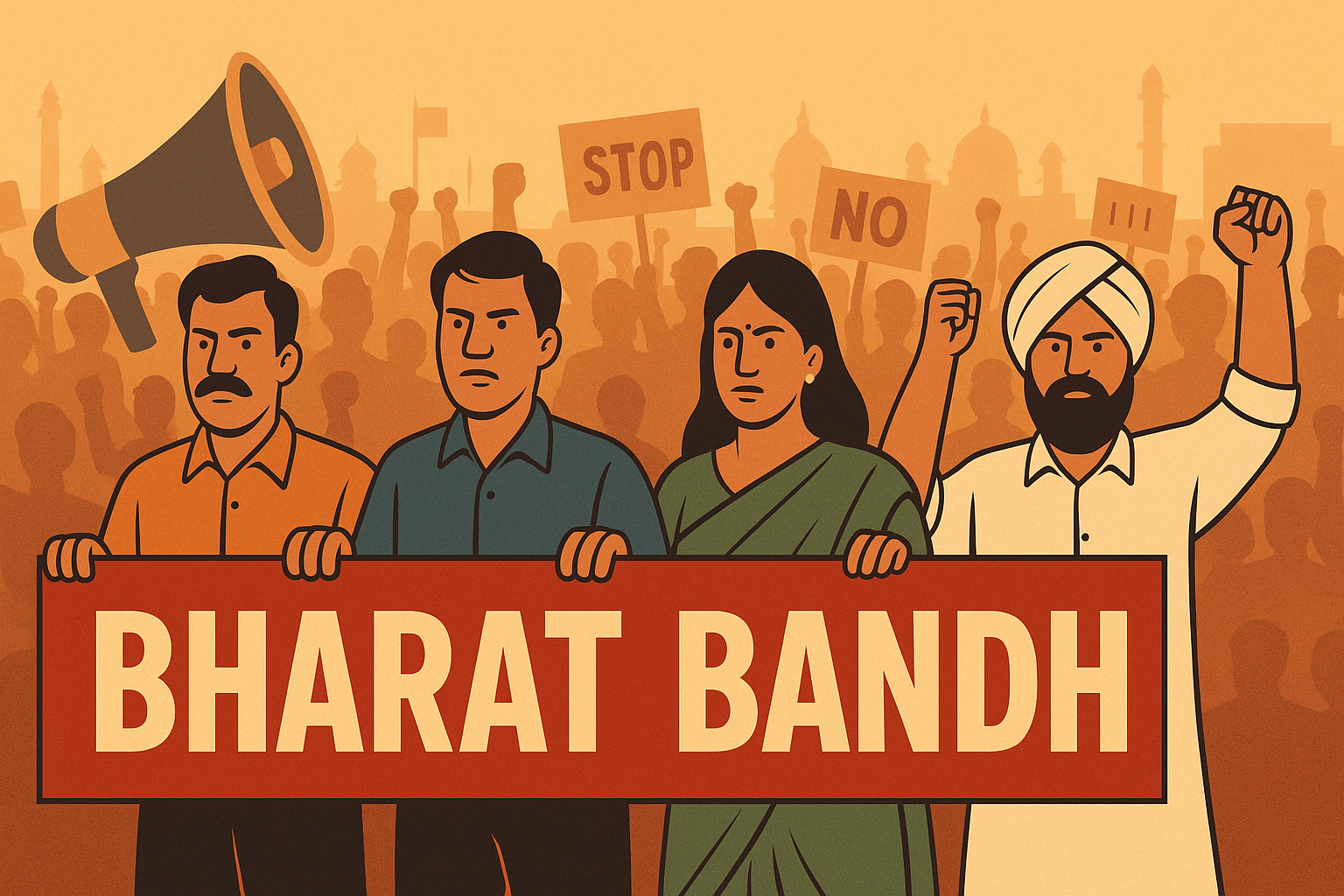The stage is set for one of India’s largest industrial actions as over 25 crore workers prepare to participate in the Bharat Bandh on Wednesday. Workers across a diverse range of sectors—including banking, insurance, postal services, coal mining, and transportation—will unite in a show of solidarity against policies they believe threaten their rights and livelihoods.
Called by a joint forum of 10 central trade unions, the strike has been dubbed a Bharat Bandh to underline its nationwide impact. Organisers describe it as a response to what they call “anti-worker, anti-farmer, and anti-national pro-corporate policies” of the central government.
This article breaks down everything you need to know about the upcoming Bharat Bandh, its key players, demands, and expected impact on public life.
What Is Bharat Bandh and Why Is It Happening?
The term Bharat Bandh literally translates to “India Shutdown” and signifies a complete halt of business and public activities. The current strike has been called to protest against government policies perceived as hostile towards workers and farmers.
At the heart of the unrest is a 17-point charter of demands submitted to Labour Minister Mansukh Mandaviya. Trade unions claim these demands—ranging from wage security and employment guarantees to withdrawal of labour reforms—have been ignored.
According to the unions, the government has also failed to convene the annual labour conference for a decade, which they say reflects its apathy towards labour issues.
Who Is Participating in Bharat Bandh?
More than 25 crore workers are expected to join the Bharat Bandh, making it one of the largest general strikes in the world. The protest enjoys support across both the formal and informal sectors.
Key Sectors Involved:
- Banking: Services across public sector banks are likely to be hit hard.
- Insurance and Postal Services: Operations may slow down or halt completely.
- Coal Mining and Factories: Production disruptions expected.
- Transport: State-run transport services may see large-scale participation, causing commuter inconvenience.
Amarjeet Kaur of the All India Trade Union Congress (AITUC) stated, “Months of preparations have led to this moment. Farmers and rural workers will also join the protest across the country.”
The Samyukta Kisan Morcha and agricultural workers’ unions have also pledged support to ensure massive mobilisations in rural India.
Why Are Workers and Farmers Protesting?
The Bharat Bandh is being staged to resist the government’s labour reforms and privatisation efforts. The trade unions allege:
✅ Labour Codes Threaten Rights – The four new labour codes passed by Parliament are said to dismantle collective bargaining, restrict strikes, and increase working hours.
✅ Privatisation Concerns – Policies promoting the privatisation of public sector enterprises and outsourcing have sparked fears of job insecurity and casualisation of the workforce.
✅ Erosion of Worker Protections – Unions argue that the government’s reforms decriminalise violations of labour laws by employers, undermining workers’ rights.
In a joint statement, the forum declared, “The government has abandoned the welfare state and is working in the interest of foreign and Indian corporates.”
Previous Bharat Bandh Strikes: A Look Back
This is not the first Bharat Bandh in recent years. Similar nationwide strikes were observed:
📅 November 26, 2020 – Protesting farm laws and labour reforms.
📅 March 28-29, 2022 – Against privatisation and unemployment.
📅 February 16, 2024 – Focused on wage security and price rise.
These events set the stage for the current strike, which organisers believe will be even larger and more impactful.
What Are the 17 Key Demands?
The unions’ demands include:
📌 Withdrawal of the four labour codes.
📌 No privatisation of public sector enterprises.
📌 Universal social security coverage for workers.
📌 Job security and an end to contractualisation.
📌 Minimum wage of ₹21,000 per month.
These demands form the core agenda of the Bharat Bandh and highlight the growing discontent among India’s working class.
Expected Impact of Bharat Bandh
The Bharat Bandh is likely to cause widespread disruption across India:
🚨 Banking Services: ATMs may run out of cash; banking operations could be delayed.
🚨 Public Transport: State-run buses and trains might face cancellations.
🚨 Essential Services: While emergency services will continue, non-essential public services could come to a standstill.
🚨 Industries: Coal production and factory outputs may see significant drops.
Harbhajan Singh Sidhu of the Hind Mazdoor Sabha warned, “The nationwide general strike will have a severe impact on key public services and industries.”
Government’s Response to Bharat Bandh
So far, there has been no official word on negotiations to call off the strike. Authorities have appealed for calm and warned against disruptions to essential services.
Security has been heightened in major cities to manage potential protests and traffic snarls during the Bharat Bandh.
Why This Bharat Bandh Matters
The Bharat Bandh is not just another strike—it is a defining moment for India’s labour movement. With participation cutting across industries and support from rural communities, it reflects deep-rooted concerns about workers’ rights, job security, and economic justice.
For ordinary citizens, the strike is a reminder of the fragile balance between economic reform and social welfare.
Final Thoughts
The upcoming Bharat Bandh underscores the power of collective action in a democracy. With over 25 crore workers joining hands, the strike sends a clear message to policymakers about the need for inclusive and fair labour reforms.
As India braces for the nationwide shutdown, the world will watch how one of the largest democracies navigates this crucial test of its labour and economic policies.

2 thoughts on ““Bharat Bandh: 25 Crore Workers Unite, Big Nationwide Impact Seen””
Comments are closed.